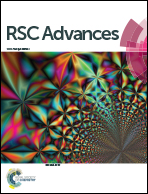Ag(i), Cu(ii), Co(iii) and Hg(ii) complexes and metal-assisted products derived from 4-methyl-piperidine-carbodithioate: syntheses, structures, thermal analyses, redox behaviour and fluorescence properties†
Abstract
Four new complexes [Ag2(4-mpipdtc)2(PPh3)2] (1), [Cu(4-mpipdtc)2] (2), [Co(4-mpipdtc)3]·CHCl3 (3) and [PhHg(4-mpipdtc)] (4) and two new products, bis(4-methyl piperidinethiocarbonyl) disulfide {(4-mpipdtc)2} (5) and (4-methyl-piperidin-1-yl) carbothioylsulfanyl-methyl (4-methyl)-piperidine-1-carbodithioate {CH2(4-mpipdtc)2} (6) have been obtained in this study. The syntheses of compounds 5 and 6 were assisted by Mn(II) and Ag(I) ions, respectively, and were obtained from potassium 4-methyl-piperidine-carbodithioate {K+(4-mpipdtc)−} {where, 4-mpipdtc− = 4-methyl piperidine carbodithioate}. All new compounds have been characterized by elemental analyses, IR, NMR, magnetic susceptibility and single X-ray crystallography techniques. These compounds are stabilized by intermolecular C–H⋯S, S⋯S, C–H⋯π and C–H⋯N interactions. The most interesting feature in complex 4 is that the ligand bound phenylmercury cation is stabilized via intermolecular as well as intramolecular Hg⋯S secondary interactions. Compounds 3 and 5 are highly fluorescent in a solution when compared to the free ligand and emit violet/violet-blue light at 372 and 413 nm upon excitation at 328 and 300 nm, respectively. The course of the thermal degradation of complexes 1–4 have been investigated by TG-DTA, which indicates that metal sulphide is formed as the final residue. The results obtained from the electronic structure calculations at the density functional theory level corroborate our experimental findings obtained from the IR data. Frontier molecular orbital analysis reveals that complexes 1 and 3 are softer and more reactive than complexes 2 and 4. Cyclic voltammetry shows that complex 2 exhibits a reversible Cu(II)/Cu(I) redox process at 0.515 V, whereas the ligand and complexes 1, 3 and 4 show irreversible redox behaviour.


 Please wait while we load your content...
Please wait while we load your content...